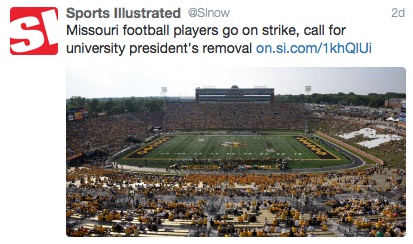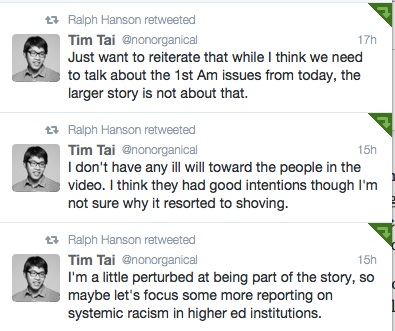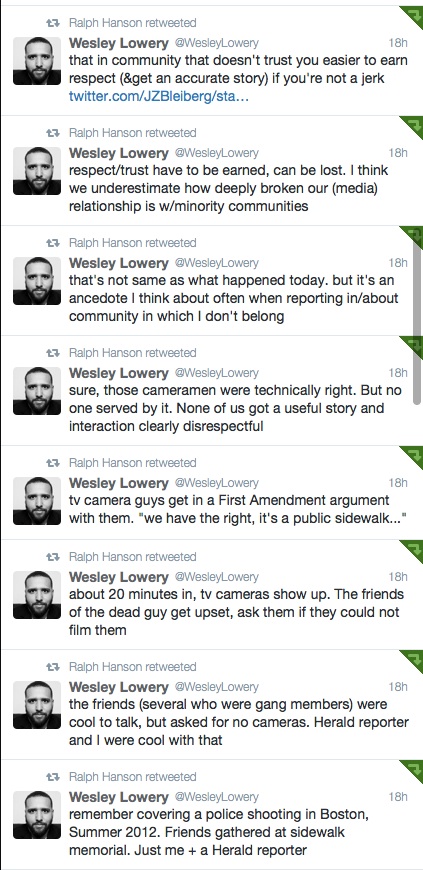 If you follow the same kind of people and media outlets on Twitter as I do, you’ve likely been overwhelmed with the firehose of news and opinions about the events at University of Missouri (Mizzou) over the last few days.
If you follow the same kind of people and media outlets on Twitter as I do, you’ve likely been overwhelmed with the firehose of news and opinions about the events at University of Missouri (Mizzou) over the last few days.
There’s been a lot of hot emotion over the story there, so let’s step back and look at what has happened.
- There is a history of incidents on the Mizzou campus that have made students unhappy (WaPo)
The history of students being unhappy with how race issues have been handled on the MU campus date back to at least August of 2014 when people marched in protest in Ferguson, Mo. over the shooting death of unarmed black 18-year-old Michael Brown. It continued on with concerns over a swastika drawn on a dorm stairwell wall, the student body president being called the n-word, a black student play rehearsal interrupted by racial slurs, mandatory diversity training, protesters blocking the university president’s car during the homecoming parade, and human feces being used to draw a swastika on the wall of a dorm bathroom. - Student action amplified by media attention can be powerful (WaPo)
Both the University of Missouri system president Tom Wolfe and Mizzou chancellor R. Bowen Loftin are resigning in response to pressure from students. These included graduate student Jonathan Butler who engaged in a week-long hunger strike to push President Wolfe to resign and said he was willing to die if that’s what it took. The MU football team also staged what might best be described as a strike, refusing the engage in football activities until President Wolfe resigned. It’s worth noting that there were financial implications to this stoppage from the team – the Kansas City Star reports that a cancellation of their upcoming game with BYU could cost MU a $1 million payment to BYU. - Anonymous responses to the resignations and protests on social media were predictably awful (MSNBC)
To no one’s surprise, the responses on social media, especially the anonymous Yik Yak, were predictably unhelpful. I’m not going to publish them here, but the link above will let you see. I received one tweet in response about the hunger striker that said:any chance those bozos will starve to death quietly? Yeah, unfortunately I didn’t think so either
To be fair, that’s the only real comment I’ve gotten back from Twitter other than retweets and likes/favorites.
Up until this point, we have a story that is primarily one about civil rights at the University of Missouri and the response to student activism on the issue. But then on Monday afternoon the story’s focus changed dramatically when the protestors turned against what had been for the most part a supportive press.
- Protestors, comm professor confront student photographer and video journalist on Mizzou campus (WaPo)
One point that needs to be made for those of you who don’t know your journalism programs is that Mizzou has a top-notch college of journalism. So it came as a surprise when the news started breaking Monday evening that student photographer Tim Tai, who was freelancing for ESPN, was physically pushed away from taking pictures from a tent city located on a central part of the Mizzou campus. Tai was told by protestors that the tent camp was a self-proclaimed “no media safe space.“
"If you're here to support the students then help keep the press out," a woman just chanted pic.twitter.com/ogA2l5G2xc
— Benjamin Hochman (@hochman) November 9, 2015
Tai’s confrontation with the protestors was captured in video by journalist Mark Schierbecker. The video shows Tai engaging the protestors politely but firmly, asserting his first amendment rights in a public space. Among the protestors was assistant professor of communication (often misidentified as a journalism faculty member) Dr. Melissa Click, who is heard on video saying:
All right, who wants to help me get this reporter out of here? I need some muscle over here.
Tai and Schierbecker have been praised for how they handled the tense situation by James Fallows on The Atlantic’s web site:
Sincere congratulations to someone who this morning had no idea he would be in the national eye. But he turned out to be, and behaved in a way that reflects credit on him and the calling of news-gathering.
The New York Times had a good story that highlighted what happened in the confrontation, and the Twitter responses from both Tai and a number of other participants.
I would note that Mr. Tai has handled his role in the story well, and he notes that the big story still needs to be the problem of racism on campus and not the first amendment issue. (And as a side note – Take a look at Tai’s photos at ESPN. Great work!)
It is worth noting that Tai has retweeted documentation today (Tuesday) that the protestors have moved on to welcoming the press.
#ConcernedStudent1950 Protestors have taken down the anti-media signs and are handing out a PSA welcoming media. pic.twitter.com/jAqgDAzqGk
— Mark Kim (@MarkJKim_) November 10, 2015
- Missouri state law mandates that all of the MU campus is a free speech zone (MU Maneater)
While Mizzou has had so-called “free speech zones” established on campus in the past, a law signed by Gov. Jay Nixon states that protests and speeches can be given on any outdoor space on the campuses of public institutions of higher learning in the state. So every outdoor space on campus is in essence a free speech zone.
Some concluding thoughts:
This story is still breaking and is far from over. But there are a few things that I think we can learn from this case study.
First, it is much easier to deal with a difficult situation when both sources and reporters work calmly and with respect for each other. While this story was going on, Washington Post reporter Wesley Lowery sent out a series of tweets talking about another story that called for calm respect that he had covered several years ago:
I can’t recommend enough Mr. Lowery’s Washington Post reporting and Twitter feed.
Secondly, I think there is one more important lesson to be learned here. Media attention can be a strong power for good or ill. But it is not something to be taken lightly. And once you have turned on the media attention, it’s very difficult to turn it off. And so I would suggest one more candidate for a Media Secret: “Media Attention Is Not A Faucet You Can Turn Off And On.”


